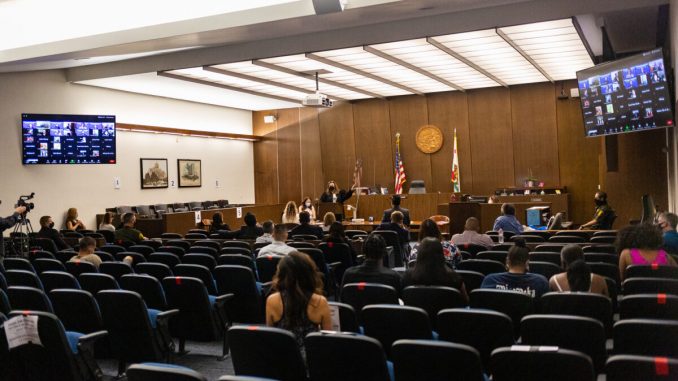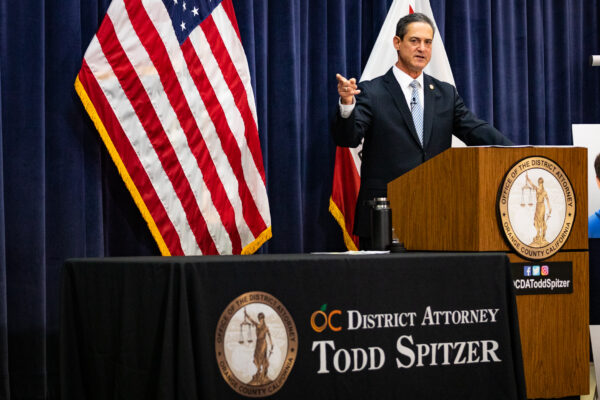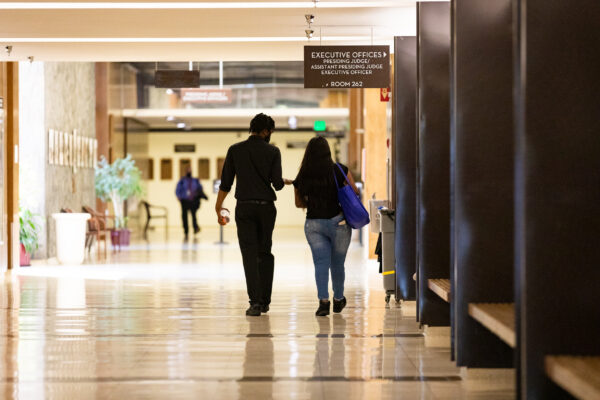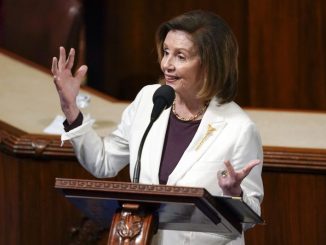
The constitutional rights of defendants are in jeopardy because of a backlogged court system and mask mandates in Orange County, a Southern California criminal attorney says.
Karren Kenney of Kenney Legal Defense told The Epoch Times that the Orange County court system is so backed up that the notions of getting a timely trial and an impartial jury have become “a joke.”
“There are no speedy trials right now, especially if you’re out of custody,” she said.
Court officials and the District Attorney’s Office say they’re doing the best they can to cope with obstacles presented during the COVID-19 pandemic and that justice is still being served. But backlogged courts, mask mandates, and limited access to district attorneys are all getting in the way of justice and the right to a fair trial, Kenney said.
Cases are being pushed back without advance notice and dealing with juries has become problematic, according to the defense attorney. Most DUI cases are not being heard at all, and clients are faced with much longer automatic driver’s license suspensions because their days in court have been delayed.
Kenney said one of her cases was continued, or postponed, without her knowledge in Fullerton’s North Court.
“They weren’t even telling me. They were just doing it on their own … and they would cite COVID,” she said. “Each court has its own procedures, but West Court was kind of doing the same thing. … The clerks were told to just continue out-of-custody arraignments, even if there was an attorney that had already made themselves known.”
Kenney said miscommunication throughout the system has left her frustrated. “They were kicking the can, and our poor clients are just wanting to resolve their cases. It’s just delaying somebody being put on probation and getting on with their lives. They were just continuing them—and didn’t care.”
Kimberly Edds, a spokesperson for the Orange County District Attorney’s Office, agreed that the courts are not hearing many out-of-custody criminal cases and that civil cases are backed up. But, she said, “claims that DAs are kicking the can down the proverbial road—that’s just flat-out false.”
“The DA cannot unilaterally continue cases … so the judges are the ones that are determining that,” she said.
California’s Chief Justice Tani Cantil-Sakauye, who leads the Judicial Council, more than a year ago empowered the state’s 58 Superior Courts to decide individually whether to suspend jury trials, prioritize criminal cases over civil cases, and use video conferencing in place of in-person court appearances during the pandemic.
But Kenney said that some in-person requirements, including mask mandates and social distancing of jurors, have been unfair to her clients.
Reading the Jury
Kenney said mask mandates in courtrooms have been detrimental to jury selection. Though some federal courtrooms allow clear face shields instead of cloth masks, Orange County courts have resisted, she said.
The masks prevented her from reading the facial expressions and behavior of potential jurors to help determine if they are going to be fair and impartial, she said—which is the defendant’s right.
“I had to do a jury trial in an attempted murder case during COVID in Orange County,” she said. It was “unfair to the defendant, just the way the court was making us do it. … I don’t intend to do another one until we don’t have to wear masks.”
During jury selection, the courts would socially distance all the candidates throughout the courtroom, Kenney said, making the process much more difficult and time-consuming.
“They could only bring in so many, because there’s only so many seats in that courtroom. So the judge would have to do the initial voir dire for just that group,” she said.
“And then we’d have to go through peremptory challenges, and as soon as we had empty seats, they would bring in more potential jurors. And we’d have to go through the process again, which took a long time.”
Kenney filed a motion against wearing the masks, arguing the jury selection process was unfair. The motion was denied and the case is now on appeal.
She did get permission to wear a face shield personally, however. “I can’t talk in a face mask and cross-examine a witness,” she said. “I got permission to wear a shield if I was standing and not moving around, questioning a witness.”
However, she couldn’t approach the jury, which she found frustrating. “I’m a very dramatic person. I’ll walk around, and I couldn’t. I was told to stay seated or stay put at the podium that was right next to me.”
After the jury was selected, four jurors were seated in the jury box—but the other eight were spread out in the courtroom, where they listened to testimony throughout the entire trial.
“As an attorney, you’ve always got to be able to see what the jury is doing, to be able to read what’s going on and who may be on your side, or if there’s somebody that’s basically not—or they’re smirking,” she said.
“You can’t get a flavor of their personality when half their face is masked, or if they’re sitting so far back in the courtroom; you can’t see if they’re on their phones, or what they’re doing back there, or if they’re even paying attention.”


Judicial Council’s Decision
Orange County District Attorney Todd Spitzer did not personally respond to requests for comment by The Epoch Times.
But Edds, the DA’s Office spokesperson, told The Epoch Times it’s up to each court—not the DA’s office—to decide whether to allow clear face shields in place of cloth face masks.
“That’s not anything that we have any say over. That’s a determination by the presiding judge, as well as individual judges in their own courtrooms,” Edds said.
Attorneys were encouraged to appear on Zoom to keep as many people out of the courtrooms as possible, according to Edds. “That was actually either a requirement or very strong urging by the Chief Justice of the Judicial Council,” she added.
“Look, the entire world has been operating virtually for a long time to protect people’s health and safety, and that’s for everybody,” said Edds. “That’s for the defendants; that’s for the judges; that’s for the jurors; that’s for absolutely everyone.”
“Of course, there is a backlog” of cases, she said—but compared to other counties, Orange County courts are faring better than most, as far as the number of trials that have been held during the pandemic. She pointed out that Orange County courts handled 100 trials before Los Angeles County handled its first.
Orange County Courts
Kostas Kalaitzidis, spokesman for the Orange County Superior Court, told the Epoch Times it’s difficult to quantify the magnitude of the backlog, including how many cases have been delayed and for how long.
He said criminal cases are being handled before civil cases because of the constitutional mandate that stipulates anyone who is arrested can’t be held or jailed for more than 48 hours, or 72 hours in some cases, before they are arraigned.
“In all this time, we managed to not let go of anybody just because we couldn’t arraign them,” he said. “That took a lot of work. That took away resources from other areas such as civil cases.”
In order to have a jury trial, “you need a certain number of people in the courtroom,” Kalaitzidis said. “That’s 12 to 14 jurors, defense attorneys, [and] clerks, with 6 feet of distancing.”
Holding jury trials presents another problem: “There are only a few courtrooms in our system that can handle it,” he said. “For example, our biggest courtroom can take 200 people. With social distancing, that’s down to 45.”
Most courtrooms can only accommodate a couple of dozen people even in normal times without social distancing requirements. “So, those become useless for jury trials,” Kalaitzidis said.
In 2020, the courts were closed under the statewide stay-at-home orders, but reopened for trials last May 26.
“Between May 26 and right now we are close to exceeding 300 jury trials, and it’s going to be a year pretty soon. In a regular year, we do between 900 and 1,000 jury trials. So indirectly you can see a backlog,” he said, adding he couldn’t provide specific statistics.
Statute of Limitations
Kenney said the backlog has had real-life impacts on her clients.
She suspects many pending cases might have been dropped because delays have caused the statute of limitations to run out, though she has no evidence to back it up. She based her opinion by judging how slowly DA offices have been operating during the pandemic.
“I’m sure statutes of limitations have been blown, but I don’t have any proof of that,” Kenney said. “It was happening before COVID, but it got much worse once COVID started. The statute of limitations is the statute of limitations. They haven’t been able to extend the filing deadlines.”
District attorneys have three years to file charges for a felony and one year for a misdemeanor. “So if you’ve got some lazy DA that’s got a stack of police reports … they can literally sit on those,” she said, as long as they file before the deadline.
Edds denied that DAs are sitting on cases and letting statutes of limitation expire.
“That’s not true. There has been no indication that there was any impact on the timeliness of our filings of new cases with the court,” Edds said.
She suggested the opposite was more likely. With reduced court operations, “we actually were able to redirect our resources to file cases quicker and reduce our backlog.”
“We’ve really, really worked hard to keep as many people out of jail as possible, to do early release without jeopardizing public safety, and to get those cases moving, because the defendant has a right to speedy trial and we take that very seriously,” said Edds.
Even before the Judicial Council adopted a no bail policy a year ago, “we established our own bail review process that would minimize pretrial incarceration, to keep as many people out of jail as possible as long as they weren’t a danger to the public safety,” she added.


Restraining Orders
Kenney said prosecution delays—because of DAs working from home—have made it more difficult to deal with domestic violence cases.
“I had a couple clients that got arrested [and] were released on bond. They’re supposed to go to court within five days, according to the statute for domestic violence. And the DA’s office was taking months—months—to file it,” she said.
The National Domestic Violence Hotline has reported an increased number of contacts during the pandemic, prompting U.S. Attorneys throughout California to launch an outreach campaign to help victims.
Kalaitzidis said he doesn’t have enough current data to substantiate claims of an uptick in domestic violence since the beginning of the pandemic. “At this time, I do not have comparative numbers to give you an accurate picture of whether there was an increase or not during the pandemic,” he said.
But he said the issuance of temporary restraining orders has remained a priority of the courts.
“The court did not stop the issuance of temporary restraining orders through the pandemic. These types of hearings and other constitutionally mandated functions took precedence, and they were our main focus throughout even the early days of the closure of our courts. … Any resident of Orange County who came to us with such needs was not turned away.”
The courts never truly closed, said Kalaitzidis. “We just minimized our work to help with containing the pandemic, but we continued to provide services as best we could.”
But according to Kenney, in one case a district attorney waited nearly a year to request a restraining order, which would require her client to move out of his house. Since then, the couple has reconciled—but the DA’s office is still insisting a protective order needs to be issued.
“There is a delay in the DAs prosecuting because everybody’s working from home,” she said. “They’re sitting on their couches in their pajamas.”
To speed up the court process, Kenney said prosecutors are making plea deal offers “that are more attractive than they normally would be” to defense lawyers and their clients, including no-custody offers.
“Plea deals have gotten better,” she said. “So in that respect, I think it’s benefiting the people charged.”
Justice Via Video
Though Kenney agreed it’s difficult to get an accurate picture of how badly the courts are backlogged, she said it was bad enough before the pandemic started—and has most likely only gotten worse.
“I would think it would have had to have gotten worse because they’re not even allowing people into the courts,” she said.
In the misdemeanor courts, some DAs “were just appearing over the phone from home,” she said.
“I’ve been told they didn’t have to actually come back to work until just this past week, so nothing could even get resolved. The defense attorneys are showing up trying to negotiate cases and the DAs aren’t even there—they’re on video.”
Last year, the courts were continuing cases for up to eight months with the hope that the pandemic would end, Kenney said, adding that DAs temporarily assigned to cases were more apt to delay them.
“They have calendar DAs that aren’t necessarily assigned to a specific case for the entire case, so they just kick the can. You have like a DA for the day, so they’re appearing on Zoom and have no specific interest to get it off their caseload,” she said.
“They don’t seem to be in any hurry to try to solve things in the long term. They just finish their caseloads for that particular day so everybody can just go home.”
If the DAs were more available to defense attorneys, it would speed up the process significantly, she added.
“DAs need to be in the courtroom, because they’re the ones prosecuting; they’re the ones with the burden of proof. They shouldn’t be working at home, because then they would be physically in their assigned courtroom—so things could be negotiated, whether it’s over the phone with a defense attorney or in person if a defense attorney wants to show up,” she said.
Edds said the DA’s Office has worked continuously with defense attorneys to prioritize cases during the pandemic.
“We worked with the defense bar to figure out which matters were time-sensitive; we handled those as priority matters. So we work in conjunction with the defense bar, and that includes the public defender and private defense attorneys,” Edds said.
“I can tell you unequivocally that our prosecutors were available all through the pandemic. They’re completely available.”
Returning to Normal
It’s too soon to say how long it will take for the courts to return to normal, according to Kalaitzidis. But “schedule adjustments are continually being made” to reduce the backlog.
“We’ll know more once the pandemic is over, and then we can go to normal operations,” he said. “The court’s schedules and calendars have been under constant revision and refinement to respond to this crisis as best as possible with existing resources and limitations.”
He said the court system has furloughed some employees, adding to the strain. “Every employee is taking a day off per month because of our budget rules. We’re not complaining about that. We’re not unique. The whole economy is in trouble because of the pandemic, but it is a reality.”
‘Silver Lining’
Prior to the pandemic, the Orange County court system upgraded to more secure databases and increased bandwidth, making it easier for the courts to function remotely, Kalaitzidis said.
“We were working towards a technological future already,” he said. For example, law firms that handle civil cases can now file electronically. “They don’t have to come to the court.”
But whether or not other changes—such as bench trials held via video conferencing—will continue when the pandemic fades remains unknown.
“It is impossible to predict at this time. That will be determined once the pandemic is over,” Kalaitzidis said. “However, the silver lining of this otherwise difficult time is that new technology was tested and was adopted in several areas of the court.”
Kenney agreed that some court procedures can be done more efficiently via video conferences, such as pretrial meetings. If an attorney has multiple court appearances scheduled for several different courtrooms, it’s much faster to appear on video than for the lawyer to drive from courthouse to courthouse, she said.
“A lot of lawyers want the option to appear remotely if they can,” Kenney said. “I don’t think they should take the remote appearances away. They should keep the video hearings.”
Overall, despite delays, justice is still being served and the court system is still operating fairly, she said.
“It’s functioning. I don’t think it’s in shambles, it’s just slow,” Kenney said. “The wheels of justice have slowed down tremendously.”





Be the first to comment